#the universal hermetic harmony principle
Explore tagged Tumblr posts
Text

Human consciousness vortex C/S/I Oniric Insular tor vortex
#universal sphere vortex#kelemen gabriel#klmn codex#the universal hermetic harmony principle#Human consciousness vortex C/S/I#Oniric Insular tor vortex
23 notes
·
View notes
Text
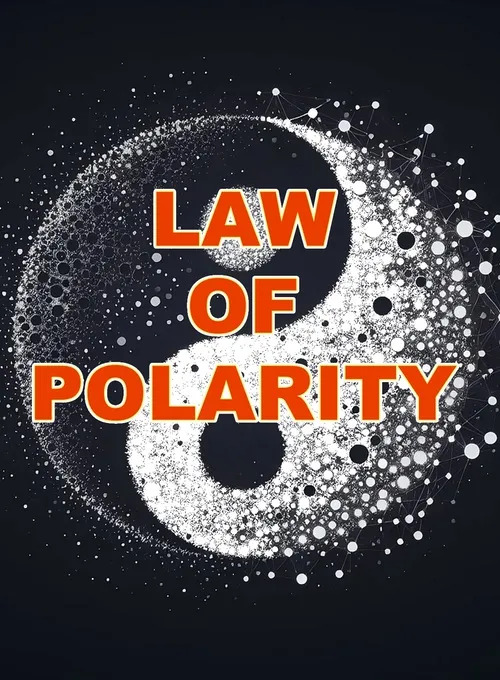
Law of Polarity https://lahilden.com/law-of-polarity/
#law of polarity#Hermetic principles#balance#yin and yang#harmony#duality#Universal law#LA Hilden#love#polarities#the kybalion
11 notes
·
View notes
Text
Unlocking the Mysteries of Existence - A Journey Through "The Kybalion"
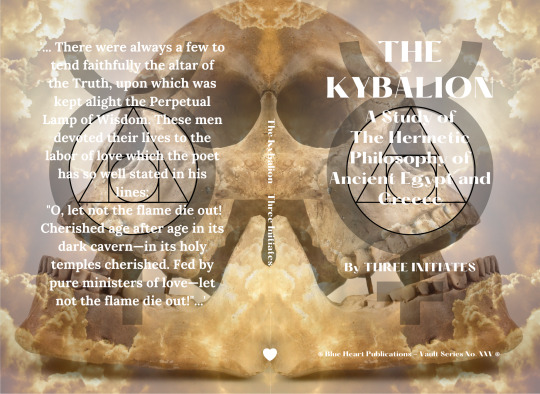
"The Kybalion: A Study of The Hermetic Philosophy of Ancient Egypt and Greece" by Three Initiates is a timeless masterpiece that unveils the profound teachings of Hermeticism, an ancient and esoteric philosophical tradition that has captivated seekers of wisdom for centuries. This enigmatic book delves into the fundamental principles governing the universe, offering readers a glimpse into the secrets of creation, transformation, and spiritual enlightenment.
At its core, "The Kybalion" explores the Seven Hermetic Principles, which are the foundation of Hermetic philosophy. These principles include the Law of Mentalism, the Law of Correspondence, the Law of Vibration, the Law of Polarity, the Law of Rhythm, the Law of Cause and Effect, and the Law of Gender. Through the wisdom contained within these principles, the book takes readers on a profound journey of self-discovery and understanding of the universe.
One of the strengths of "The Kybalion" is its ability to present complex metaphysical concepts in a clear and accessible manner. The Three Initiates, who remain anonymous, have crafted a text that is both profound and practical. Each principle is explained with examples and analogies, making it easier for readers to grasp the depth of Hermetic wisdom. The authors also emphasize the interconnectedness of these principles, highlighting how they work in harmony to shape our reality.
What sets this book apart is its focus on the practical application of Hermetic principles in everyday life. It encourages readers to harness the power of their thoughts, emotions, and actions to transform themselves and their circumstances. By understanding and aligning with the Hermetic Laws, individuals can achieve personal growth, spiritual evolution, and a deeper connection to the cosmos.
"The Kybalion" also delves into the concept of mental transmutation, which is the process of consciously shifting one's thoughts and emotions to create a more positive and harmonious life. This idea is particularly relevant in today's world, where the importance of mindfulness and the law of attraction is widely recognized.
However, it's important to approach "The Kybalion" with an open mind and a willingness to contemplate its teachings deeply. Some readers may find the ideas challenging or even contradictory to conventional beliefs. Yet, therein lies the beauty of Hermeticism—it invites exploration and introspection, encouraging individuals to question and seek their own truth.
In conclusion, "The Kybalion" is a profound and enlightening work that has the power to transform the lives of those who delve into its pages. It serves as a timeless guide to understanding the mysteries of the universe, the power of the mind, and the path to spiritual awakening. Whether you are a seasoned seeker of esoteric wisdom or a newcomer to Hermeticism, this book offers a valuable and life-changing journey into the heart of ancient philosophical teachings.
"The Kybalion: A Study of The Hermetic Philosophy of Ancient Egypt and Greece" by Three Initiates is available in Amazon in paperback 12.99$ and hardcover 20.99$ editions.
Length of the book: 198 pages
Language: English
Rating: 10/10
Link of the book!
Review by: King's Cat (its a Paw-e-some! book!)
#Hermeticism#Ancient Wisdom#Seven Hermetic Principles#Spiritual Enlightenment#Universal Laws#Mental Transmutation#Law of Correspondence#Esoteric Philosophy#Self-Transformation#Cosmic Harmony#Mindfulness#Law of Vibration#Law of Polarity#Law of Rhythm#Law of Cause and Effect#Law of Gender#Hermetic Teachings#Practical Spirituality#Metaphysical Concepts#Inner Alchemy
7 notes
·
View notes
Text
Unlocking the Mysteries of Existence - A Journey Through "The Kybalion"
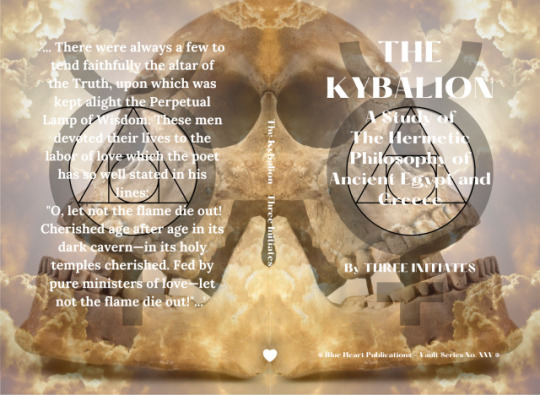
"The Kybalion: A Study of The Hermetic Philosophy of Ancient Egypt and Greece" by Three Initiates is a timeless masterpiece that unveils the profound teachings of Hermeticism, an ancient and esoteric philosophical tradition that has captivated seekers of wisdom for centuries. This enigmatic book delves into the fundamental principles governing the universe, offering readers a glimpse into the secrets of creation, transformation, and spiritual enlightenment.
At its core, "The Kybalion" explores the Seven Hermetic Principles, which are the foundation of Hermetic philosophy. These principles include the Law of Mentalism, the Law of Correspondence, the Law of Vibration, the Law of Polarity, the Law of Rhythm, the Law of Cause and Effect, and the Law of Gender. Through the wisdom contained within these principles, the book takes readers on a profound journey of self-discovery and understanding of the universe.
One of the strengths of "The Kybalion" is its ability to present complex metaphysical concepts in a clear and accessible manner. The Three Initiates, who remain anonymous, have crafted a text that is both profound and practical. Each principle is explained with examples and analogies, making it easier for readers to grasp the depth of Hermetic wisdom. The authors also emphasize the interconnectedness of these principles, highlighting how they work in harmony to shape our reality.
What sets this book apart is its focus on the practical application of Hermetic principles in everyday life. It encourages readers to harness the power of their thoughts, emotions, and actions to transform themselves and their circumstances. By understanding and aligning with the Hermetic Laws, individuals can achieve personal growth, spiritual evolution, and a deeper connection to the cosmos.
"The Kybalion" also delves into the concept of mental transmutation, which is the process of consciously shifting one's thoughts and emotions to create a more positive and harmonious life. This idea is particularly relevant in today's world, where the importance of mindfulness and the law of attraction is widely recognized.
However, it's important to approach "The Kybalion" with an open mind and a willingness to contemplate its teachings deeply. Some readers may find the ideas challenging or even contradictory to conventional beliefs. Yet, therein lies the beauty of Hermeticism—it invites exploration and introspection, encouraging individuals to question and seek their own truth.
In conclusion, "The Kybalion" is a profound and enlightening work that has the power to transform the lives of those who delve into its pages. It serves as a timeless guide to understanding the mysteries of the universe, the power of the mind, and the path to spiritual awakening. Whether you are a seasoned seeker of esoteric wisdom or a newcomer to Hermeticism, this book offers a valuable and life-changing journey into the heart of ancient philosophical teachings.
"The Kybalion: A Study of The Hermetic Philosophy of Ancient Egypt and Greece" by Three Initiates is available in Amazon in paperback 12.99$ and hardcover 20.99$ editions.
Length of the book: 198 pages
Language: English
Rating: 10/10
Link of the book!
Review by: King's Cat (its a Paw-e-some! book!)
#Hermeticism#Ancient Wisdom#Seven Hermetic Principles#Spiritual Enlightenment#Universal Laws#Mental Transmutation#Law of Correspondence#Esoteric Philosophy#Self-Transformation#Cosmic Harmony#Mindfulness#Law of Vibration#Law of Polarity#Law of Rhythm#Law of Cause and Effect#Law of Gender#Hermetic Teachings#Practical Spirituality#Metaphysical Concepts#Inner Alchemy
0 notes
Text


The Swastika Symbol 卍 The Buddhist swastika is called "manji" (卍) in Japanese, and it is known as "wan" (卍, 万)" in Chinese. In Sanskrit, it is referred to as "svastika" (स्वस्तिक), which means "conducive to well-being," derived from "su-" (good, auspicious) and "asti" (to be, to exist).
Meaning & Symbolism in Buddhism
In Buddhist tradition, the manji (swastika) is a sacred and auspicious symbol representing harmony, eternity, and the interconnectedness of all things. Its arms, usually turning to the left (counterclockwise, 卍) in East Asian Buddhism or to the right (clockwise, 卐) in Indian traditions, symbolize the revolving forces of Dharma and the eternal cycle of life, death, and rebirth (Samsara).
Deeper Symbolism
Cosmic Harmony – It represents the balance of opposites (like yin and yang in Taoism), reflecting the unity of all phenomena. Buddha’s Heart and Footprint – In many Buddhist iconographies, the swastika is found on the chest or palms of statues of the Buddha, signifying his infinite wisdom and compassion. The Wheel of Dharma (Dharmachakra) – The swastika is a geometric simplification of the eight-spoked Dharma Wheel, showing the ever-moving cosmic order of the universe. Four Cardinal Directions – It extends to the fourfold nature of existence (North, South, East, West), linking it to space and the infinite expanse of reality.
Esoteric Buddhist Perspectives
In Vajrayāna Buddhism, the swastika often appears in mandalas and yantras as a gateway to higher consciousness. It is also associated with certain Bodhisattvas, particularly Maitreya, the future Buddha.
In Japanese Esoteric Buddhism (Shingon), the manji is a symbol of the primordial truth and the cosmic reality of Mahāvairocana Buddha (Dainichi Nyorai)—the central deity in many tantric practices.
Connection to Other Traditions
In Jainism, it represents the four states of existence: gods, humans, animals, and hell-beings. In Hinduism, it is a solar symbol linked to Surya (the Sun), Vishnu, and Ganesha. In Western Esotericism, the swastika has been used as a solar, alchemical, and Hermetic emblem, predating its later misappropriations.
The Buddhist Swastika (Manji) in Western Hermeticism and Qabalah
The manji (卍 / 卐) in Buddhist symbolism aligns deeply with principles found in Western Hermetic Qabalah, Alchemy, and Tarot, especially when understood as a rotating force of cosmic balance, evolution, and divine will.
1. The Swastika as the Rotating Cross of the Elements (Tetragrammaton & Tiphareth)
In the Western Hermetic tradition, the cross (☩) is a foundational symbol, representing the four elements, the four directions, and the divine tetragrammaton (יהוה - Yod-Heh-Vav-Heh). The swastika, being a rotating cross, adds the idea of motion, transformation, and the eternal turning of the cosmos.
Tiphareth (תפארת), the Solar Sephirah in Qabalah, aligns perfectly with the swastika’s solar connotations, particularly in Hindu and Buddhist traditions. The Golden Dawn viewed the swastika as a rotating force that could symbolize either constructive (deasil, clockwise) or destructive (widdershins, counterclockwise) currents, akin to the alchemical cycles of dissolution and coagulation.
This movement mirrors the Hermetic axiom: "As above, so below"—the continual unfolding and refolding of divine patterns in the physical world.
2. Tarot and the Breath of the Swastika (Manji)
If we think of Tarot as a breath cycle, the swastika represents the continuous inhale and exhale of divine energy through the suits and elements.
The Four Arms of the Swastika = The Four Suits of the Minor Arcana Wands (Fire) – Creative motion, the Will in action Cups (Water) – Emotional currents, the inner spiral of the soul Swords (Air) – Thought’s dynamic process, movement in mind Disks (Earth) – The physical realization of spiritual laws
Thus, the swastika aligns with The Wheel of Fortune (X) in the Major Arcana, which reflects the perpetual turning of karma, dharma, and cosmic cycles.
3. The Swastika and the Qabalistic Lightning Flash
In Hermetic Qabalah, the Lightning Flash of Creation, which descends from Kether to Malkuth (forming the path of divine emanation), has a rotational counterpart: the return ascent of consciousness—aligning with the swastika’s cyclical motion.
The descent (clockwise, 卐) aligns with the involution of divine force into matter The ascent (counterclockwise, 卍) represents spiritual return, enlightenment, and Nirvana
This matches the Buddhist idea that the swastika embodies the eternal path of awakening—a journey from illusion (Malkuth) back to divine unity (Kether).
4. Esoteric Alchemy: The Swastika as the Prima Materia
In Alchemy, the swastika symbolizes the dynamic transformation of the Prima Materia (first matter) into the Philosopher’s Stone.
The turning arms represent the alchemical process: Calcination (Fire), Dissolution (Water), Separation (Air), and Conjunction (Earth). In this sense, the manji is a glyph of transmutation—the constant reworking of base consciousness into divine gold.
This echoes Vajrayāna Buddhist teachings, which treat the mundane world as raw material for enlightenment, just as an alchemist transmutes lead into gold.
5. The Swastika as the Key to Magickal Motion (Chokmah’s Whirlwind)
Chokmah (חכמה) in Qabalah is associated with the whirlwind of divine motion—it is not static wisdom but active, living force, the archetypal "Will to Evolve."
In this sense, the swastika is a glyph of Chokmah’s energy descending into creation (Yod, the first spark) The rotation signifies the primal whirlwind, the storm of existence, which eventually crystallizes into form (Binah, structure).
Thus, the manji is a cosmic yantra of divine will in perpetual movement—never fixed, always flowing. Final Synthesis: Manji as the Breath of the Divine
The Buddhist swastika is a universal expression of the Hermetic Great Work:
1.It shows the interplay of creation and dissolution, much like the Tree of Life and the Lightning Flash. 2.It is a breath—inhale (form), exhale (transformation)—mirroring the cycle of Tarot and Qabalah. 3.It represents the eternal journey of the soul, the Wheel of Fortune turning through Samsara toward ultimate enlightenment. -Tarot of Eli
66 notes
·
View notes
Text
5 Occult Concepts That Explain the World Better Than Science

Throughout my extensive research into occult philosophy, I’ve been fortunate to gain a ton of knowledge that has truly enriched my understanding of the world. This journey has been deeply personal, as it has allowed me to explore the hidden corners of my mind and connect with a broader spiritual and philosophical landscape.
What I’ve come to realize during this time is profound: if the world weren’t so rigid and complex, we could all live and practice our lives in such diverse and meaningful ways that are truly personalized to our unique needs and desires. This realization has inspired me to seek out a more balanced and harmonious existence, one that embraces the individuality and creativity that lie within each of us. It’s also motivated me to share this knowledge with you all, hoping to spark a similar sense of wonder and empowerment in your own lives!
Now don’t get me wrong; science is brilliant at breaking things down—atoms, ecosystems, the expansion of the universe. It gives us answers, solutions, and a framework to navigate the physical world. But let’s be honest: science often trips over itself when trying to explain the messy, intangible, and deeply human parts of existence.
The cracks where logic doesn’t fit? That’s where the occult slips in. Occult philosophy thrives on the edges of understanding. It doesn’t just ask “how”—it asks “why,” “what if,” and “what does this mean for me?” While science maps reality in clean, objective terms, the occult dives into the subjective, the mysterious, and the uncomfortable truths that can’t be measured in a lab.
Here are five esoteric concepts that, in their raw and provocative nature, offer a far more compelling explanation of the world than science ever could:

1. As Above, So Below: The Reflective Nature of Reality
This phrase is a cornerstone of hermetic philosophy, a cryptic little mantra that implies the micro mirrors the macro, and vice versa. In simpler terms: the structure of the universe can be seen in the structure of a single human life.
Science has its own version of this idea in fractals and self-similarity across scales—patterns that replicate endlessly from the molecular level to the cosmic. But where science stops at structure, the occult digs deeper.
As above, so below isn’t just a reflection of patterns; it’s a commentary on how everything—your struggles, desires, and choices—ties into larger systems. Your internal chaos mirrors societal chaos. A broken relationship might reflect a deeper imbalance in your worldview. It’s not just poetic metaphor; it’s a map for self-awareness.
When science shrugs at the meaning of human patterns, the occult says, Look closer. What’s happening out there is happening in here, too.

2. The Law of Correspondence: Connection Beyond Logic
Occult philosophy insists that nothing exists in isolation. Every force, event, or idea has a counterpart. Correspondence suggests that unrelated things—symbols, objects, emotions—are part of an invisible web of connection. You lose something important, and suddenly, you’re flooded with strange coincidences that feel almost intentional.
What science brushes off as statistical anomalies, the occult embraces as part of the design. For example, synchronicity—the idea that unrelated events can feel meaningfully connected—is often dismissed by science as cognitive bias.
Yet, anyone who’s experienced these “coincidences” knows they carry a weight science can’t quantify. Correspondence doesn’t just explain why these events happen; it dares to ask what they mean. It argues that your personal reality is shaped not just by physical actions but by symbols, metaphors, and the unseen forces tying them all together.

3. The Hermetic Principle of Polarity: Duality Without Simplicity
In science, opposites are defined by contrast: positive and negative, light and dark, heat and cold. The occult, however, sees polarity not as opposition but as two ends of the same spectrum. Hot and cold, for instance, are both expressions of temperature; they’re not enemies, just different manifestations of the same underlying force.
The principle of polarity teaches that extremes are always interconnected. Love and hate, joy and grief—they aren’t separate forces battling for dominance. They’re two expressions of the same energy. This doesn’t just help explain emotional complexity; it’s a tool for navigating life. Feeling overwhelmed by fear?
Polarity suggests that courage isn’t its opposite—it’s a reframing of the same energy. Science is great at measuring extremes, but it struggles with the liminal space between them. The occult lives in that in-between, showing how the line between opposites is much thinner than it seems.

4. The Rule of Threefold Return: Consequence Beyond Physics
Karma often gets watered down into a pop-culture idea of “what goes around comes around.” But the occult’s threefold law takes it further, suggesting that every action—good, bad, or indifferent—comes back with amplified force.
Cast harm into the world, and harm returns not as punishment but as a natural ripple of that consequence. Put good into the world, and its return carries exponential weight. Science traditionally examines phenomena through straightforward cause-and-effect relationships, often focusing on linear progressions where one event leads directly to another.
However, it often struggles to capture the complex and layered nature of our decisions, which can produce effects that multiply and interact in unexpected ways. Our actions as humans don't just create simple, predictable outcomes; they can initiate chains of events that grow in complexity and impact over time, creating a web of consequences that are difficult to predict or quantify using standard scientific methods.
Why does a single act of kindness resonate so deeply? Why does unchecked anger spiral into unforeseen consequences? The occult’s perspective on consequences isn’t moralistic; it’s mechanical. This concept is as much about accountability as it is about empowerment. It forces you to think beyond the immediate result of your actions, asking: What are the ripples I’m setting in motion?

5. The Alchemical Process: Transformation as a Cycle
Alchemy is often reduced to the pursuit of turning lead into gold—a quaint historical footnote in science’s evolution. But true alchemy was never just about metal. It was—and still is—a philosophy of transformation. Lead and gold are metaphors for the self. The base material (lead) represents the parts of you that are raw, unformed, and heavy. Gold is the refined self—lighter, brighter, and forged through struggle.
Science can tell you how cells regenerate, how the brain processes trauma, how habits form. But alchemy explains the why behind transformation. It frames struggle not as a problem to be solved but as an integral part of growth.
Calcination, dissolution, and coagulation form the stages of a chemical journey that mirrors the human experience of transformation and self-discovery. The process begins with calcination, a fiery purification that strips away the unnecessary, burning away the dross to reveal the essential core beneath. This is a time of intense reflection, where one begins to cast aside the illusions and impurities accumulated over time.
Next comes dissolution, a stage of deep introspection where old structures and beliefs are broken down. It is a time for letting go of outdated habits and ideas, much like dissolving bonds that once seemed unbreakable. This phase requires courage, as it involves dismantling one's protective barriers, leaving behind comfort zones to explore the unfamiliar.
Finally, there's coagulation, the phase of reconstruction. Here, from the remnants of the past, something new and robust is forged. It's the alchemical rebirth, where a person emerges transformed, having integrated the lessons learned from the previous stages. This rebuilding is not simply a return to the original state, but an evolution into an entity more aligned with one’s true self.
Through each stage, the journey can be deeply personal, reflecting a unique path of self-awareness and growth. Calcination, dissolution, and coagulation are not merely chemical stages but serve as a profound blueprint for personal evolution, guiding one towards a deeper understanding of themselves and the world around them.
This transformative cycle encourages embracing change, fostering resilience, and celebrating the unfolding of a renewed identity. Where science provides explanations, alchemy offers profound meaning. It asserts that transformation isn’t merely possible—it’s inevitable, provided you’re willing to endure the transformative fire.

Why the Occult Makes You Ask Better Questions
Science excels at answers. It gives us the tools, cures, and frameworks to navigate the tangible. But answers, for all their value, are useless without the right questions. This is where the occult shines. It doesn’t care about tidy conclusions; it cares about pulling you deeper into the unknown, daring you to challenge what you think you understand.
Occult principles don’t aim to replace science—they simply just… fill in its gaps. They explain not just the mechanics of life but the meaning, the purpose, the strange and chaotic connections that defy logic.
They don’t seek to fix the world; they ask what the world is asking of you. And sometimes, just by asking the right question; life is far more enjoyable than always trying to find the answers.

taglist ; dm or reply to be added 🫶🏾
@slenders1ckn3ss @lucistarsfire @mai2themai @fond-illusion @p00lverinecentral @ambidextrousarcher
#article#occult philosophy#occultism philosophy#occult#occultism#philosophy#writer#writing#queer writers#as above so below#threshold return#alchemy#5 concepts#hermeticism#law of correspondence#occult vs. science#paganism#oliolioxenfreewrites#esotericism#writeblr
50 notes
·
View notes
Text
cool stuff from In Thy Name
Hi! So, I'm doing a little summary of sources and books mentioned in In Thy Name that I've read or skimmed through in the past, in case anyone is interested in some devil worshipping with Viktor :v
Heinrich Cornelius Agrippa, De Occulta Philosophia – Ok, so Agrippa was an interesting dude and we start with him because he's my favourite, worth reading about. He was born on the same day as me! My biggest flex lol. He was a philosopher, an occultist, an astrologist (back in the day astrology was an actual science!) and an alchemist. His most famous book is actually three volumes and it's packed with philosophy around magick. He was part of a hermetic circle and his work sort of dictated the direction for further scientific developments. He talks about connections between astrology, Kabbalah, Christianity, Greek and Babylonian mythos, very, very cool read.
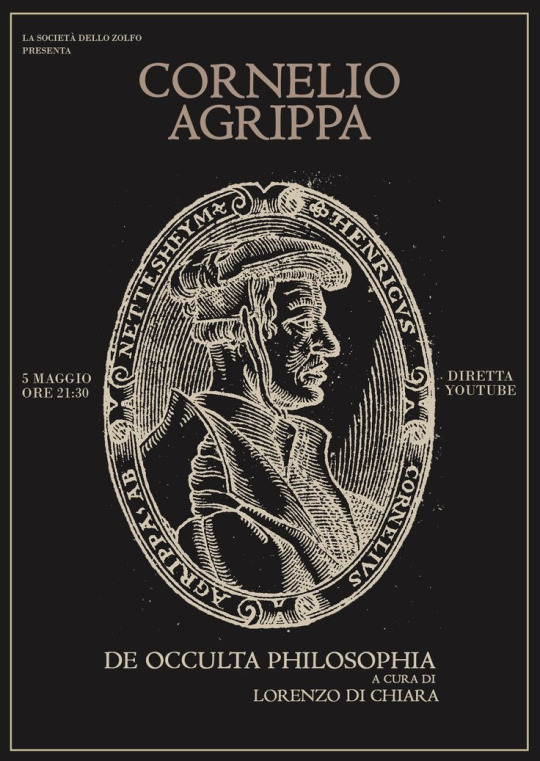
Johann Weyer, Pseudomonarchia Daemonum – grimoire from 1577 that describes the hierarchic structure of hell. Weyer was a famous occultist. It's literally a list of demons and what's their job.
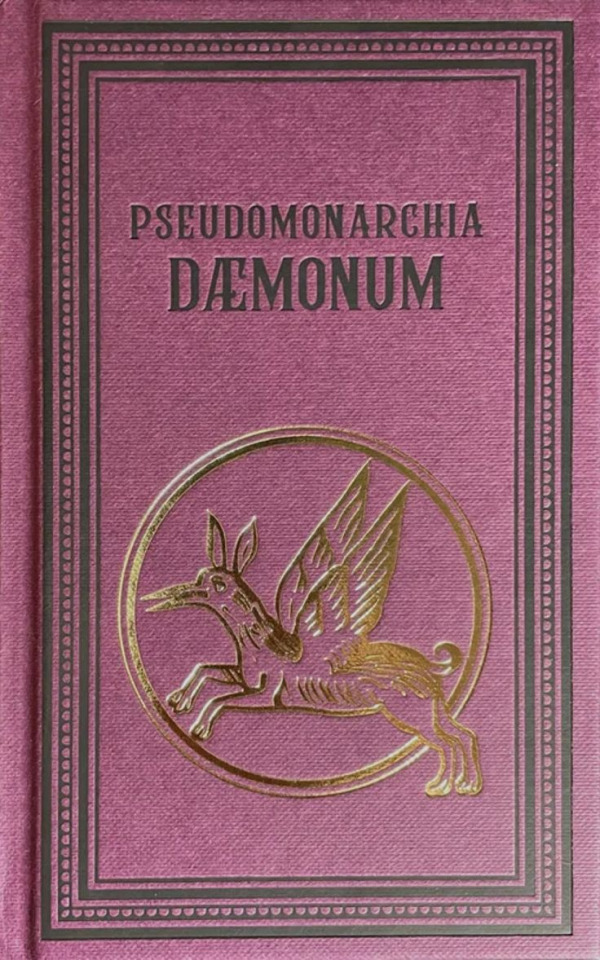
John Dee, Propaedeumata Aphoristica - another cool bloke, he was a mathematician, astronomer, teacher, astrologer, occultist, and alchemist as well, they just didn't stop with one title lol. Again, it uses knowledge of the era to descipher the sky, astronomy and astrology. All works of Dee are worth checking out!
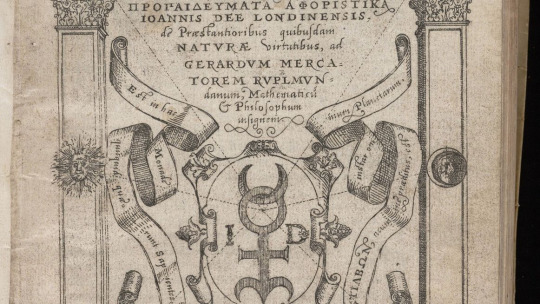
Athanasius Kircher, Ars Magna Lucis et Umbrae - awesome, awesome book, the first time people got to see what Saturn might look like! Kircher also worked in many fields, his main focus was comparative religion and medicine.
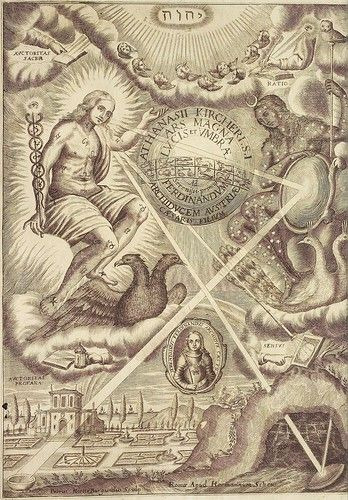
Antoine Court de Gébelin, Le Monde Primitif - he was a protestant pastor who dabbed in divination with Tarot! He was possibly the first person to spot the connection between Tarot and the civilization of ancient Egypt, which was later picked up by Etteilla, another French occultist who propagated divination with tarot cards and influenced Marie Anne Lenormand, one of the first cartomancers. Then the gospel spread and we got our occultist celebrity Aleister Crowley with his Thoth Deck.
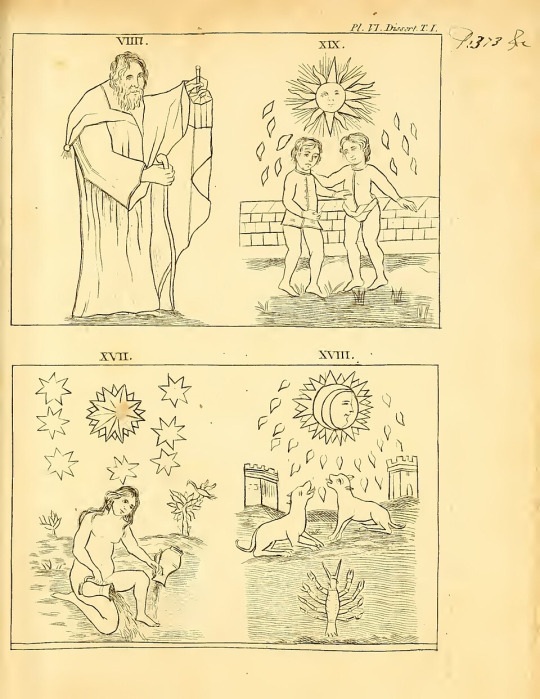
And honorable mentions:
⟡ De Re Metallica by Georgius Agricola - compendium on metallurgy ⟡ The Elements of Geometry by Euclid - a massive book on maths ⟡ The Mathematical Principles of Natural Philosophy by Isaac Newton - mostly on Newton's laws of motion and his law of universal gravitation ⟡ Ptolemy’s Almagest - on the apparent motions of the stars and planetary paths ⟡ Kepler’s Harmonices Mundi - on harmony and congruence in geometrical forms and physical phenomena ⟡ De Rerum Natura by Lucretius - on Epicurean physics but through a poetic form
When it comes to sources I am using to inject some Slavic Mythology into the story:
Slavic Mythology by Jakub Bobrowski & Mateusz Wrona - I am so, so sad that this is not translated, because it's probably my favourite book on the matter. It's written like a legend and conjoins most of what we know on Slavic mythos into a beautiful story of creation.
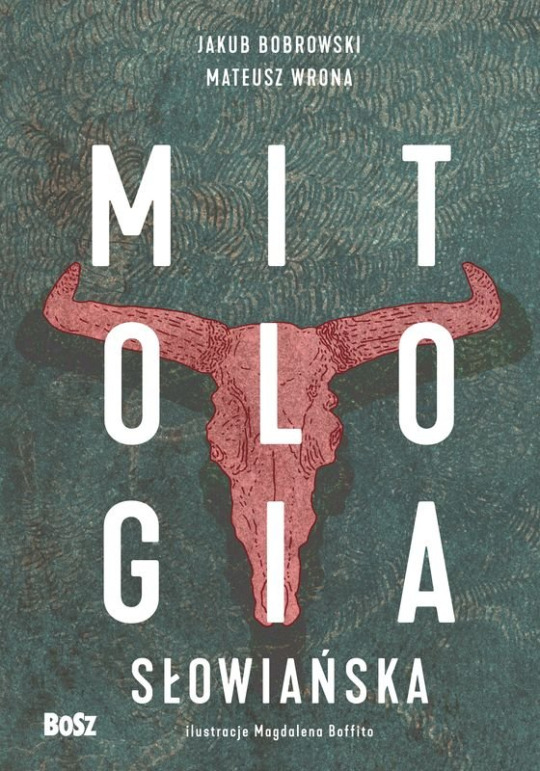
Slavic Bestiary by Witold Vargas and Paweł Zych - an awesome list of Slavic Mythology creatures and their origin!
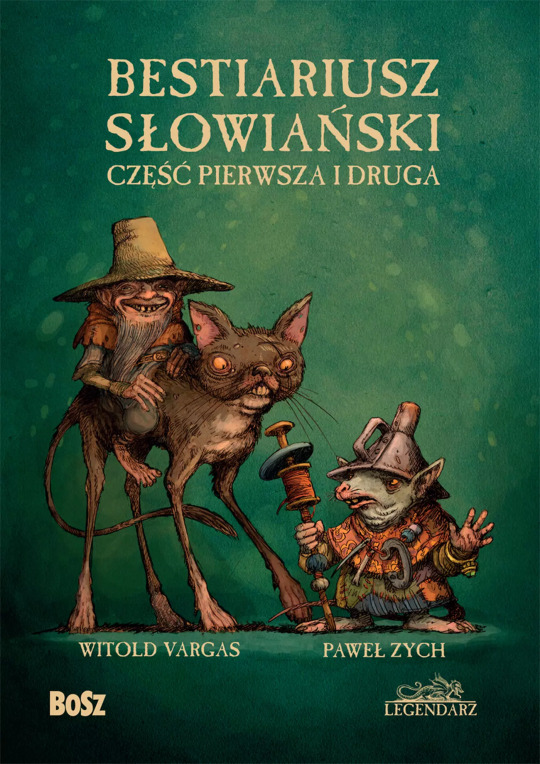
20 notes
·
View notes
Text


"The Principles of Truth are Seven; he who knows these, understandingly, possesses the Magic Key before whose touch all the Doors of the Temple fly open." --The Kybalion.
The Seven Hermetic Principles, upon which the entire Hermetic Philosophy is based, are as follows:
1. The Principle of Mentalism.
2. The Principle of Correspondence.
3. The Principle of Vibration.
4. The Principle of Polarity.
5. The Principle of Rhythm.
6. The Principle of Cause and Effect.
7. The Principle of Gender.
THE SEVEN HERMETIC PRINCIPLES From: The Kybalion, by Three Initiates
To keep your energy aligned, listen to 528 Hz (DNA repair), 963 Hz (higher consciousness), 432 Hz (universal harmony), and 741 Hz (spiritual protection). Sound shapes reality—use it to tune your frequency. Galactic Federation
@GalacticArrival feeling >> knowing
Image: Celestial Harmonics Mahaboka
7 notes
·
View notes
Text
The Rosicrucians are a mystical and esoteric society that traces its origins to early 17th-century Europe, though its philosophies and influences are thought to extend much further back. This group is named after its symbol, the Rosy Cross, which is a combination of a rose and a cross, signifying a blend of mysticism, alchemy, and spiritual transformation. The origins, beliefs, and influences of the Rosicrucians offer a fascinating glimpse into the intertwining of mysticism, science, and religion during a pivotal era in European history.
The Rosicrucian movement came to public attention with the publication of three manifestos between 1614 and 1617: the *Fama Fraternitatis*, the *Confessio Fraternitatis*, and the *Chymical Wedding of Christian Rosenkreutz*. These works introduced the legendary founder, Christian Rosenkreutz, a mysterious figure who was said to have traveled through the Middle East and North Africa, acquiring esoteric knowledge before founding the secret society in Europe. The manifestos called for a reformation of mankind, emphasizing the need for a deeper understanding of nature, science, and spirituality, which were seen as interconnected.
The Rosicrucian philosophy is deeply rooted in alchemical and hermetic traditions, which seek the transformation of both matter and spirit. Alchemy, often misunderstood as merely the pursuit of turning base metals into gold, was actually a complex spiritual discipline aimed at achieving personal enlightenment and spiritual purification. The Rosicrucians believed in the hidden truths of the natural world, which could be uncovered through meditation, study, and adherence to specific mystical practices.
One of the central tenets of Rosicrucian thought is the concept of esoteric knowledge, or knowledge reserved for a select few who are deemed spiritually and intellectually prepared to receive it. This knowledge was believed to lead to a deeper understanding of the universe and the divine, bridging the gap between science and religion. The Rosicrucians advocated for a universal reformation of society, where science and spirituality could coexist and complement each other, leading to an enlightened and harmonious world.
The influence of Rosicrucianism extended far beyond its immediate historical context. It played a significant role in the development of various esoteric traditions, including Freemasonry and the Theosophical Society. The Rosicrucian emphasis on the interconnectedness of all things and the pursuit of hidden wisdom has also resonated with various modern spiritual and philosophical movements.
In contemporary times, several organizations claim to carry on the Rosicrucian tradition, each with its own interpretation of the original teachings. Among the most well-known is the Ancient and Mystical Order Rosae Crucis (AMORC), founded in the early 20th century. AMORC and similar groups continue to explore and promote the Rosicrucian principles of spiritual development, esoteric knowledge, and the harmonious integration of science and spirituality.
In summary, the Rosicrucians represent a unique blend of mysticism, science, and spirituality that has fascinated and influenced thinkers and seekers for centuries. Their teachings emphasize the pursuit of hidden knowledge, the transformation of the self, and the harmonious union of science and spirituality, ideals that continue to inspire modern spiritual and esoteric movements. Through their rich history and enduring legacy, the Rosicrucians invite us to explore the deeper mysteries of existence and our place within the cosmos.
#rosicrucian#esoteric#mysticism#alchemy#hermetismo#spirituality#occult#christian rosenkreutz#secret societies
3 notes
·
View notes
Text
The Ultimate Guide to Mastering the 12 Universal Laws
No matter if you're skeptical or an apologist of the 12 Universal Laws can be used to make positive changes within your own life. These laws are based upon spiritual principles, such as Ho'oponopono, and hermetic philosophical theories that date back to ancient Egypt. The Law of Polarity is an illustration of the Universal Law. It states that everything has two poles. This includes hatred and love or night and day. The Law of Attraction Every person has a part of their life they want to alter. It could be your relationship or job, or your financial situation There are a few steps you can follow to manifest what you desire. Like attracts like, which is the most well-known universal law. That means that whatever that you concentrate on, will get. To apply this law, you'll be a happy person who is focused on nourishing your soul emotions such as gratitude, love, and abundance. It's therefore important to know all 12 universal law to be in sync with them. The Law of Vibration The law of physics is inviolable and explains that everything is energy. This includes our thoughts, beliefs, as well as our feelings. If we emit higher frequencies it attracts experiences that resonate with the same frequency. It's similar to the way quantum physicists explain atoms interacting at an atomic scale even across space and time. Following this law implies that you focus on your thoughts and feelings in order to maintain a high vibration and this in turn leads to your life experiences that you wish to experience. This law also recognizes that you aren't just the body you are in and that your positive energy has the power to manifest your highest desires in the physical world. The Law of Cause and Effect The Law of Cause and Effect states that for every action that is taken, there will be an equal and opposite reaction. It's a little like Newton's Third Law, however with more of a spiritual twist. It's also linked to the law of karma. It states that you reap the seeds you have sown. It means that good deeds are rewarded while bad ones will be punished, even though it's not always obvious. The beauty of this law, Kumar explains, is that you have the ability to select your triggers and bring about the changes you wish to be able to see in your life. The Law of Compensation
youtube
A very close relative to the Law of Sowing and Reaping It is believed that whatever effort, energy or love you put into the Universe will return to you as a reward. It is not only limited to financial matters, but also actions like kindness toward strangers which can have far-reaching implications for the planet as well as our fellow humans. Imagine the universe as an accountant who tracks everything that you think, feel or speak. It is crucial to guard your thoughts and words as this will influence the reality you live in! The Law of Perpetual Transmutation of Energy The law states that everything changes from one form to the next. It's like water turning into an ice cube rain, steam, or snow. Energy will never go away; it just shifts into a new shape. The most frequent natural transformation on Earth is due to cosmic rays which result in carbon-14 and the radioactive decaying of nuclides that were created at the beginning of our Solar System. These include the elements thorium, uranium, potassium-40 and thorium. On a personal level this law states that lower energies can be transformed into higher ones, by changing your energy, and changing your negative feelings to positive ones. This can be accomplished through self-reflection that is constructive and actively choosing to behave in ways that inspire you. The Law of Gender The Law of Gender doesn't refer to sex in the way we think of it, but rather the opposite energies that are present in us: one nurtures and the other that is driving. Kaiser states that harmony between these energies can help us to become more authentic. If you're naturally goal-oriented and assertive try to balance this out by balancing the ability to feel empathy and trust. Relax into the natural rhythm of life and develop a deep sense of interconnection with all living creatures. Harmonize your masculine and female aspects so that they are no longer at odds but harmoniously. The Law of Rhythm The Universe is governed by a periodic ups-and-downs. As the tides rise and flow, the seasons change and the days become nights and vice versa. This is also true of our personal and professional life experiences. Knowing this law will assist you in releasing your any resistance you may encounter during difficult times and be aware that the hardships will not last forever. It also teaches you to appreciate the highs, and to be prepared for the downs. You shouldn't be surprised by the good times. They always come. Be sure to stay clear of anxiety-related extremes such as excessive excitement or excessive depression. Watch the video here
2 notes
·
View notes
Text


sunrise sunset vortex
#kelemen gabriel#klmn codex#timisoara#archetypes#the universal hermetic harmony principle#sunrise sunset vortex
20 notes
·
View notes
Text

The concept of ghost cooking evokes themes of cleanliness, purity, and order in the kitchen, as well as the idea of leaving no trace behind after preparing a meal.
In the realm of esoteric and Hermetic principles, a few key concepts could be associated with ghost cooking:
1. Alchemy: In alchemical teachings, transformation is a central theme. The act of ghost cooking could symbolize the process of transforming raw ingredients into a nourishing meal, while leaving behind only a pristine and harmonious space. This idea reflects the alchemical pursuit of transmutation and purification.
2. Correspondences: Within Hermetic traditions, the principle of correspondence holds that there is a connection between the microcosm (the individual) and the macrocosm (the universe). Ghost cooking, with its focus on creating a clean and organized kitchen environment, may mirror the desire to align one's inner world with external harmony and order.
3. Ritual and Intention: Like other forms of culinary art, ghost cooking could be seen as a ritualistic practice that is infused with intention and mindfulness. By approaching cooking in a methodical and meticulous way, practitioners of ghost cooking may seek to elevate the act of meal preparation into a sacred and transformative experience.
Overall, the underlying esoteric and Hermetic principles of ghost cooking may involve themes of transformation, purification, harmony, and intentionality in the kitchen space. By engaging in this practice, individuals may not only create delicious meals but also cultivate a sense of spiritual connectedness with the act of cooking itself.
2 notes
·
View notes
Text
The Enigmatic Origins of Ancient Magic and Beliefs
The origins of ancient magic and beliefs are shrouded in the mists of time, making it a fascinating and intricate subject of study. These practices, which have influenced countless civilizations throughout history, are a testament to the human drive to understand and interact with the unseen forces that shape our world. In this article, we delve into the enigmatic beginnings of ancient magic and beliefs, tracing their evolution across different cultures and epochs. Check their site to know more details ฝันเห็นช้างตกมันอาละวาด.
Prehistoric Roots
Magic and beliefs can be traced back to the earliest human societies, with evidence of shamanistic practices and animistic beliefs dating back tens of thousands of years. In these prehistoric cultures, shamans served as intermediaries between the physical and spiritual realms, harnessing the power of natural elements and spirits to heal, protect, and predict the future. These practices laid the foundation for the development of more elaborate belief systems and magical traditions.
Mesopotamia: Cradle of Civilization
The ancient Mesopotamian civilizations, including Sumer, Babylon, and Assyria, played a crucial role in shaping magical and religious practices. Cuneiform texts from these societies reveal incantations, rituals, and magical spells that aimed to control various aspects of life, from health to agriculture. The concept of gods and goddesses, with their unique powers and domains, further influenced the magical beliefs of these early civilizations.
Egyptian Mysticism
Ancient Egypt is renowned for its rich tradition of mysticism, magic, and belief in the afterlife. The Egyptian Book of the Dead, a collection of spells and rituals, guided the deceased through the perilous journey to the afterlife. Magic was integral to their religious practices, and priests held a significant role in performing rituals to ensure harmony between the physical and spiritual worlds.
Greco-Roman Syncretism
The Hellenistic period witnessed a fusion of Greek and Egyptian magical traditions, creating a syncretic system known as Hermeticism. The Hermetic writings, attributed to Hermes Trismegistus, encompassed a wide range of esoteric knowledge, including alchemy, astrology, and theurgy. The influence of these writings extended into the Roman Empire and persisted through the Middle Ages.
Ancient China
In ancient China, Daoist and Confucian beliefs incorporated magical practices such as divination, exorcism, and alchemy. These practices aimed to achieve balance and harmony with the Dao, the fundamental principle that underlies the universe. Chinese emperors sought guidance from oracles and divination techniques to make important decisions.
The Mysteries of Mesoamerica
The Maya, Aztec, and Inca civilizations of Mesoamerica developed complex belief systems that intertwined magic, religion, and astrology. Rituals involving blood sacrifice, celestial observations, and communication with the spirit world were fundamental aspects of their cultures. The knowledge of these civilizations, especially the Maya, continues to baffle researchers, revealing a deep connection between ancient magic and the understanding of the cosmos.
The Middle Ages: Alchemy and the Occult
During the Middle Ages, magic and beliefs took on new dimensions in Europe. Alchemy, the precursor to modern chemistry, aimed to transform base metals into gold and discover the elixir of life. The study of the occult sciences, including astrology, numerology, and the Kabbalah, became prevalent among scholars and mystics.
Conclusion
The origins of ancient magic and beliefs are a testament to humanity's enduring quest to comprehend and harness the mystical forces that shape our world. From the shamanic practices of prehistoric societies to the syncretic traditions of Greco-Roman times and the mysticism of ancient China, these beliefs have left an indelible mark on the development of human culture. While many ancient magical practices have evolved into modern religions and scientific disciplines, they continue to captivate our imagination, providing a link to our enigmatic past and the timeless quest to unlock the secrets of the universe.
4 notes
·
View notes
Text
The Principle of Correspondence. "As above, so below; as below, so above"– The Kybalion. This Principle embodies the truth that there is always a Correspondence between the laws and phenomena of the various planes of Being and Life. The old Hermetic axiom ran in these words: "As above, so below; as below, so above." [...] This Principle is of universal application and manifestation, on the various planes of the material, mental, and spiritual universe– it is an Universal Law. [...] Just as a knowledge of the Principles of Geometry enables man to measure distant suns and their movements, while seated in his observatory, so a knowledge of the Principle of Correspondence enables Man to reason intelligently from the Known to the Unknown. [...] [Three Initiates 1908, pp. 28–30.]
The Planes of Correspondence. "As above, so below; as below, so above."—The Kybalion. The great Second Hermetic Principle embodies the truth that there is a harmony, agreement, and correspondence between the several planes of Manifestation, Life and Being. This truth is a truth because all that is included in the Universe emanates from the same source, and the same laws, principles, and characteristics apply to each unit, or combination of units of activity, as each manifests its own phenomena upon its own plane. [...] [Three Initiates 1908, pp. 113–114.]
[...] The old Hermetic axiom, "As above so below," may be pressed into service at this point. Let us endeavor to get a glimpse of the workings on higher planes by examining those on our own. The Principle of Correspondence must apply to this as well as to other problems. Let us see! On his own plane of being, how does Man create? Well, first, he may create by making something out of outside materials. But this will not do, for there are no materials outside of THE ALL with which it may create. Well, then, secondly, Man pro-creates or reproduces his kind by the process of begetting, which is self-multiplication accomplished by transferring a portion of his substance to his offspring. But this will not do, because THE ALL cannot transfer or subtract a portion of itself, nor can it reproduce or multiply itself— in the first place there would be a taking away, and in the second case a multiplication or addition to THE ALL, both thoughts being an absurdity. Is there no third way in which MAN creates? Yes, there is—he CREATES MENTALLY! And in so doing he uses no outside materials, nor does he reproduce himself, and yet his Spirit pervades the Mental Creation. Following the Principle of Correspondence, we are justified in considering that THE ALL creates the Universe MENTALLY, in a manner akin to the process whereby Man creates Mental Images. [...] [Three Initiates 1908, pp. 68–69]
[...] The student will, of course, realize that the illustrations given above are necessarily imperfect and inadequate, for they represent the creation of mental images in finite minds, while the Universe is a creation of Infinite Mind—and the difference between the two poles separates them. And yet it is merely a matter of degree—the same Principle is in operation—the Principle of Correspondence manifests in each—"As above, so Below; as Below, so above." And, in the degree that Man realizes the existence of the Indwelling Spirit immanent within his being, so will he rise in the spiritual scale of life. This is what spiritual development means—the recognition, realization, and manifestation of the Spirit within us. Try to remember this last definition—that of spiritual development. It contains the Truth of True Religion. [Three Initiates 1908, pp. 99–100.]
Three Initiates (1908). The Kybalion: A Study of the Hermetic Philosophy of Ancient Egypt and Greece. Chicago: The Yogi Publication Society.
#Hermetic Philosophy#The Kybalion: A Study of the Hermetic Philosophy of Ancient Egypt and Greece#Esoteric Tradition#Perennial Philosophy
0 notes
Text

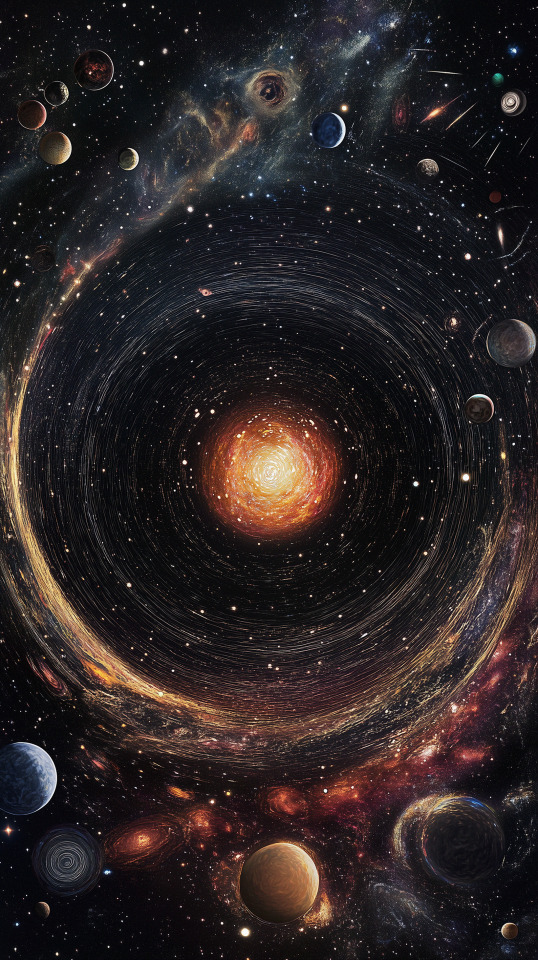
The source of consciousness cannot be the object in consciousness. To know the source is to be the source. When you realize that you are not the person, but the pure and calm witness, and that fearless awareness is your very being, you are the being. -Nisargadatta Maharaj, I Am That (1973) Solar Logos Talon Abraxas The sacred mantram "the Logos in the Cosmos and the God in Man" is more than a cryptic algebraic formula for the correlation of forces between cosmic Nature and the human principles. It intimates the identity in esse of the ever-present matrix of all worlds and the sovereign immortal spirit of Man. The complete realization of this close union and harmonious concord is the fruition of the Hermetic discipline of conscious invocation of the Invisible Sun, which alone can unveil the manifold Logoic mystery of the Tetraktys. As there is no ultimate ontological distinction between divine and human nature, every sincere effort to comprehend the function of the triple Logoi within and beyond the cosmos involves a self-conscious awakening of the afflatus of the higher Triad in man. This primary fact of spiritual life stands behind the teaching of The Voice of the Silence that "Thou canst not travel on the Path before thou hast become that Path itself."
34 notes
·
View notes
Text

~ "The caduceus, an ancient Hermetic and Alchemical Symbol, is a profound representation of universal principles, the unity of opposites, and the flow of energy that sustains life and consciousness. Its secrets lie embedded in its structure, encoding layers of spiritual, energetic, and physiological truths.
1. The Dual Serpents - Balance of Opposites: The intertwined serpents symbolize duality—the interplay of positive and negative, masculine and feminine, yin and yang. They represent polarized forces that govern creation, perpetually weaving in balance and harmony. In the alchemical tradition, these serpents signify the solve et coagula process, the dissolution and recombination of energies necessary for transformation. 2. The Central Staff - The Axis of Unity: The staff at the center represents the axis mundi, the spine or central pillar that bridges heaven and earth. It is the channel through which life force flows, often equated with the kundalini energy in Eastern traditions. This staff symbolizes the neutral force that harmonizes the opposites—the divine will that unites dualities into a singular creative purpose. 3. The Wings - Ascension and Illumination: The wings atop the caduceus represent the transcendence of material limitations and the ascent of the soul toward higher realms of consciousness. In hermetic thought, they signify the culmination of spiritual alchemy—the liberation of the spirit from the confines of duality and physicality, allowing for divine union and cosmic awareness. 4. The Spherical Brain - The Crown of Consciousness: In this particular depiction, the brain is placed at the pinnacle, signifying its role as the throne of soul energy and consciousness. It reflects the idea that illumination and mastery come from aligning the energetic flow within the body with the divine intelligence of the cosmos. 5. The Five Energy Waves - The Flow of Life Force: The diagram highlights five radiating energy waves, tied to the senses and the breath of life. These waves reflect the interplay of the body’s systems (respiratory, digestive, generative, and eliminative) with the forces of polarity. This resonates with the Hermetic axiom, “As above, so below,” where the microcosmic human body mirrors the macrocosmic universe. 6. Soul Energy and Ultrasonic/Radiant Light Energy: The energy at the top of the diagram is labeled as “soul energy,” suggesting that the caduceus is not merely a physical or physiological map but a representation of the soul’s journey. Ultrasonic energy can be interpreted as the unseen, vibrational force of creation, while radiant light energy symbolizes the spiritual illumination that guides all life. 7. The Hermetic Secret - Unity in Duality: The deeper secret of the caduceus lies in its demonstration of unity within duality. The serpents do not oppose each other but interweave harmoniously, showing that opposites are not to be conquered but reconciled. This reconciliation is the alchemist’s Great Work: the merging of spirit and matter, the finite and the infinite, into a perfected state of being. The Alchemical Insight: The caduceus is a living map of transmutation. It teaches that the path to enlightenment requires navigating the interplay of opposites, harmonizing the energies within oneself, and ascending toward higher awareness. It is a call to awaken the divine potential within, to rise through the energetic centers, and to become a co-creator in the universal flow of life. This ancient symbol, revered across cultures and times, continues to remind us of the sacred dance of creation, the alchemical transformation of the self, and the eternal truth: that harmony, balance, and unity lie at the heart of all existence." ~
1 note
·
View note